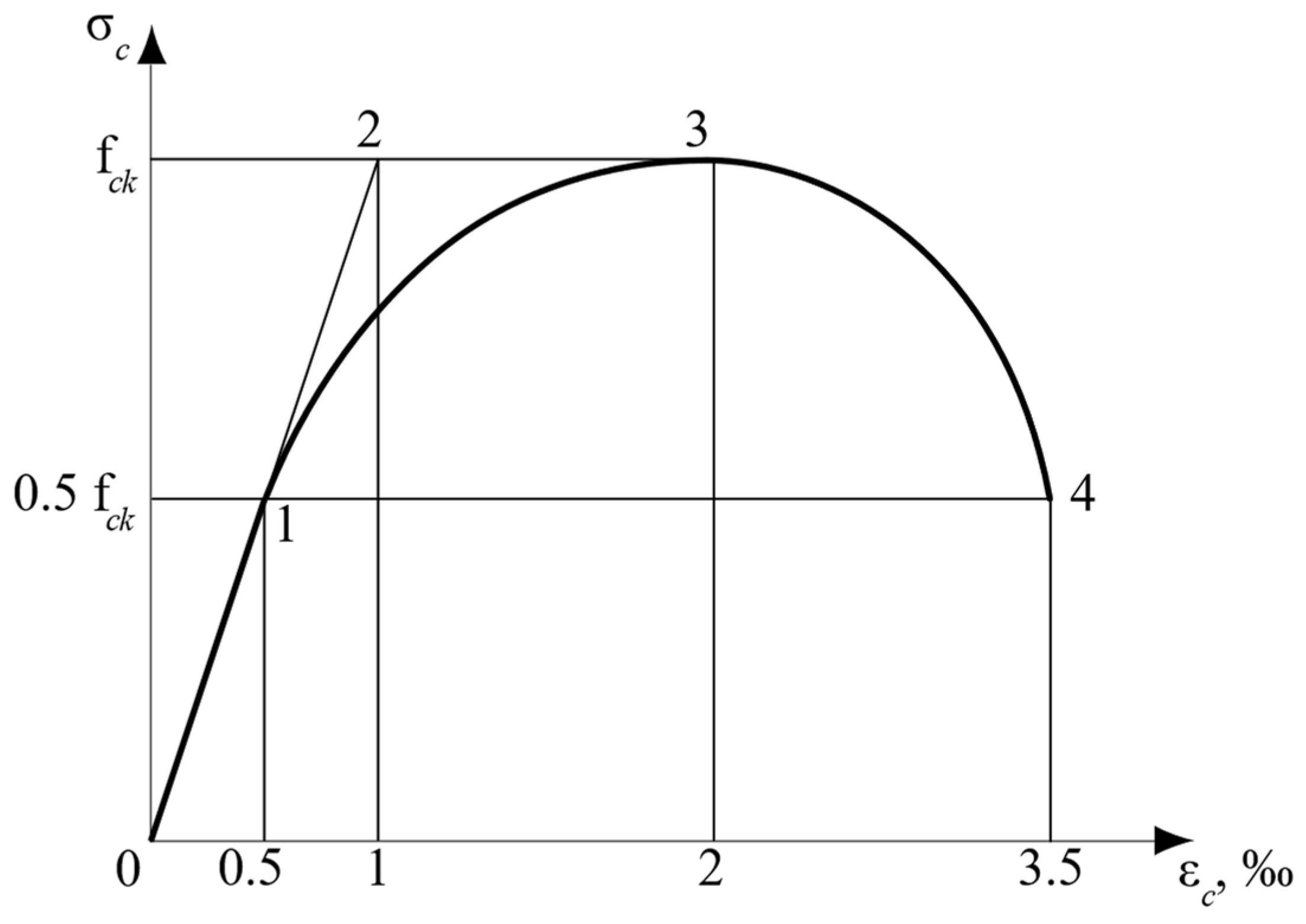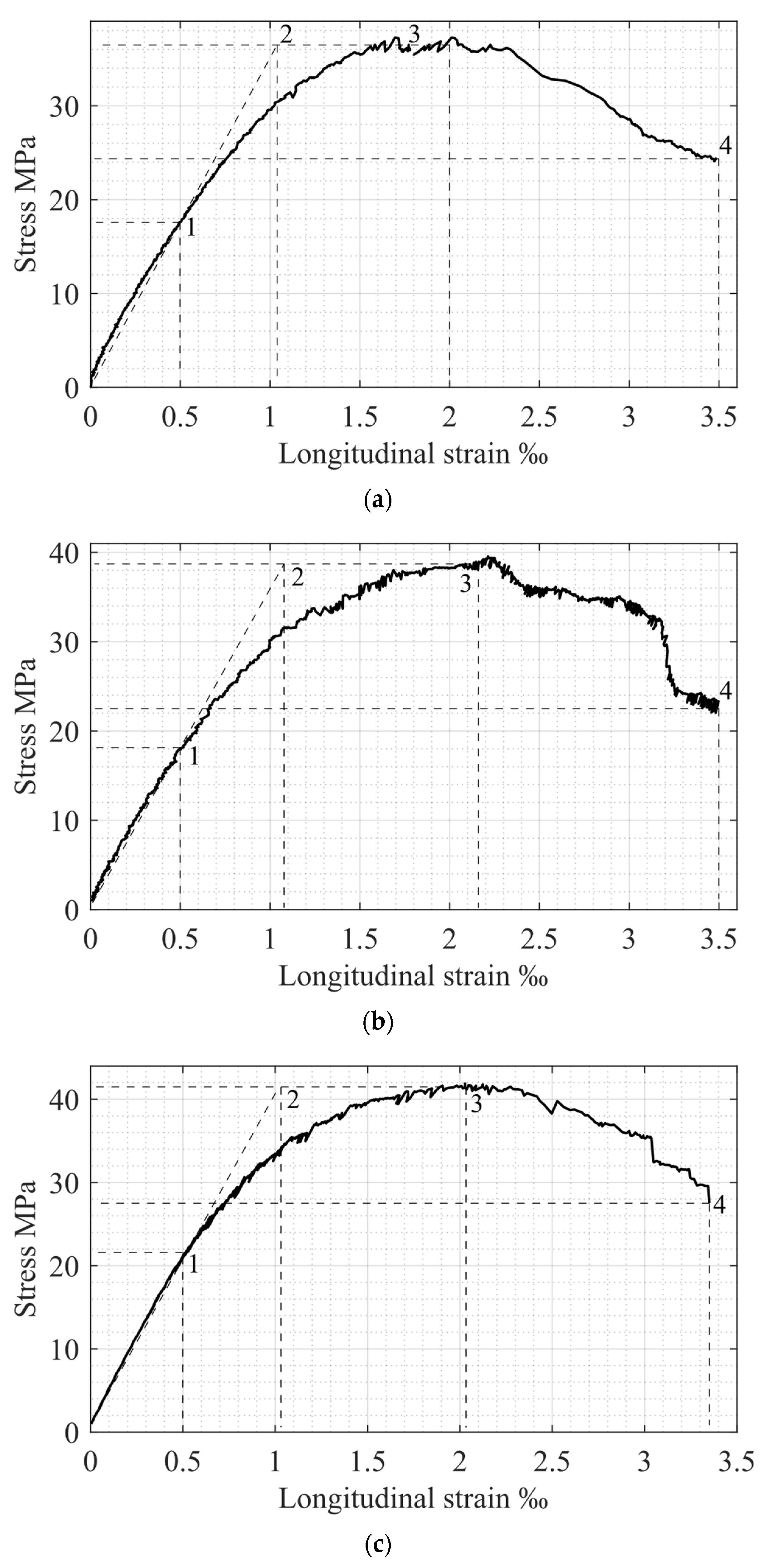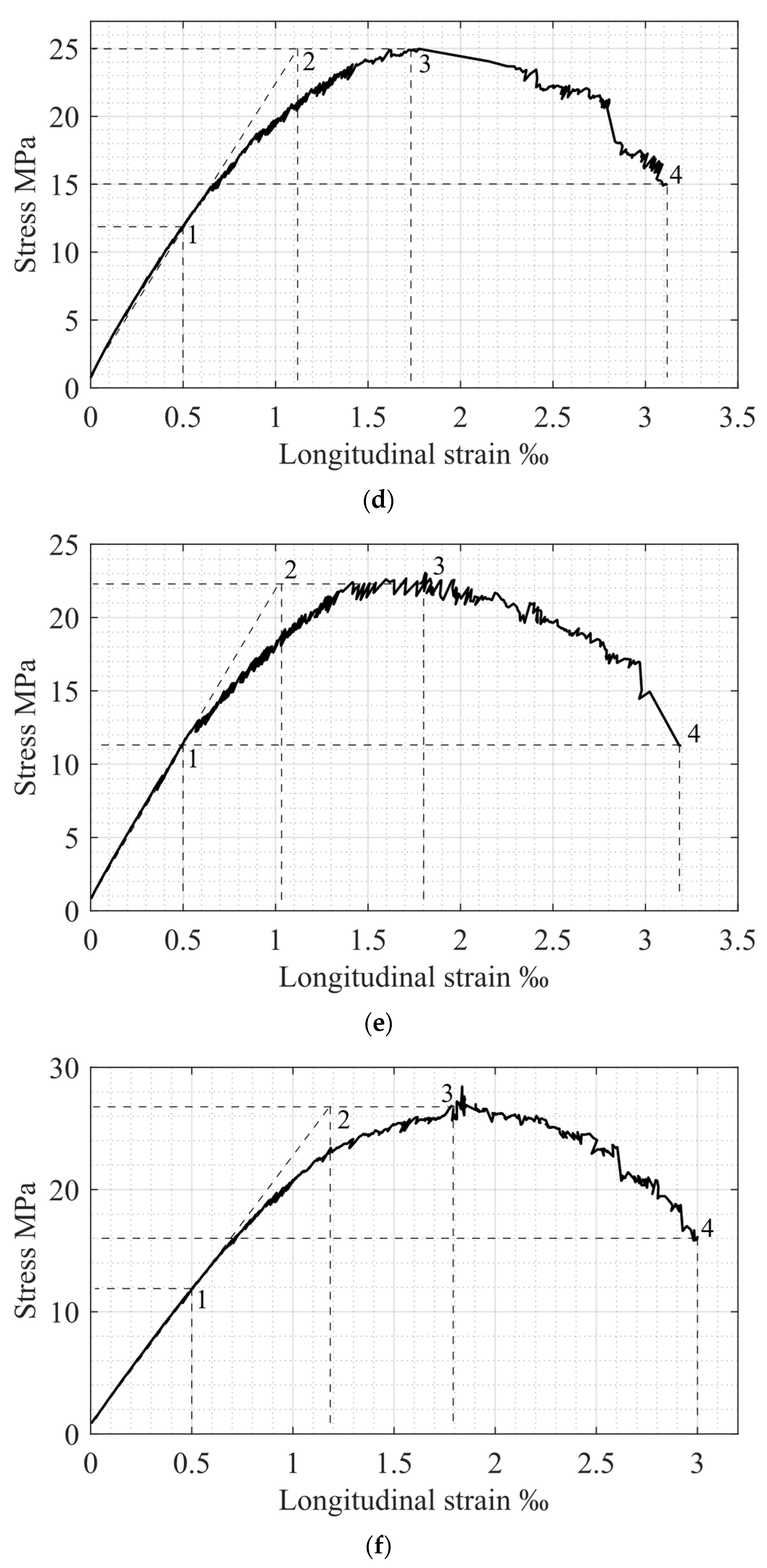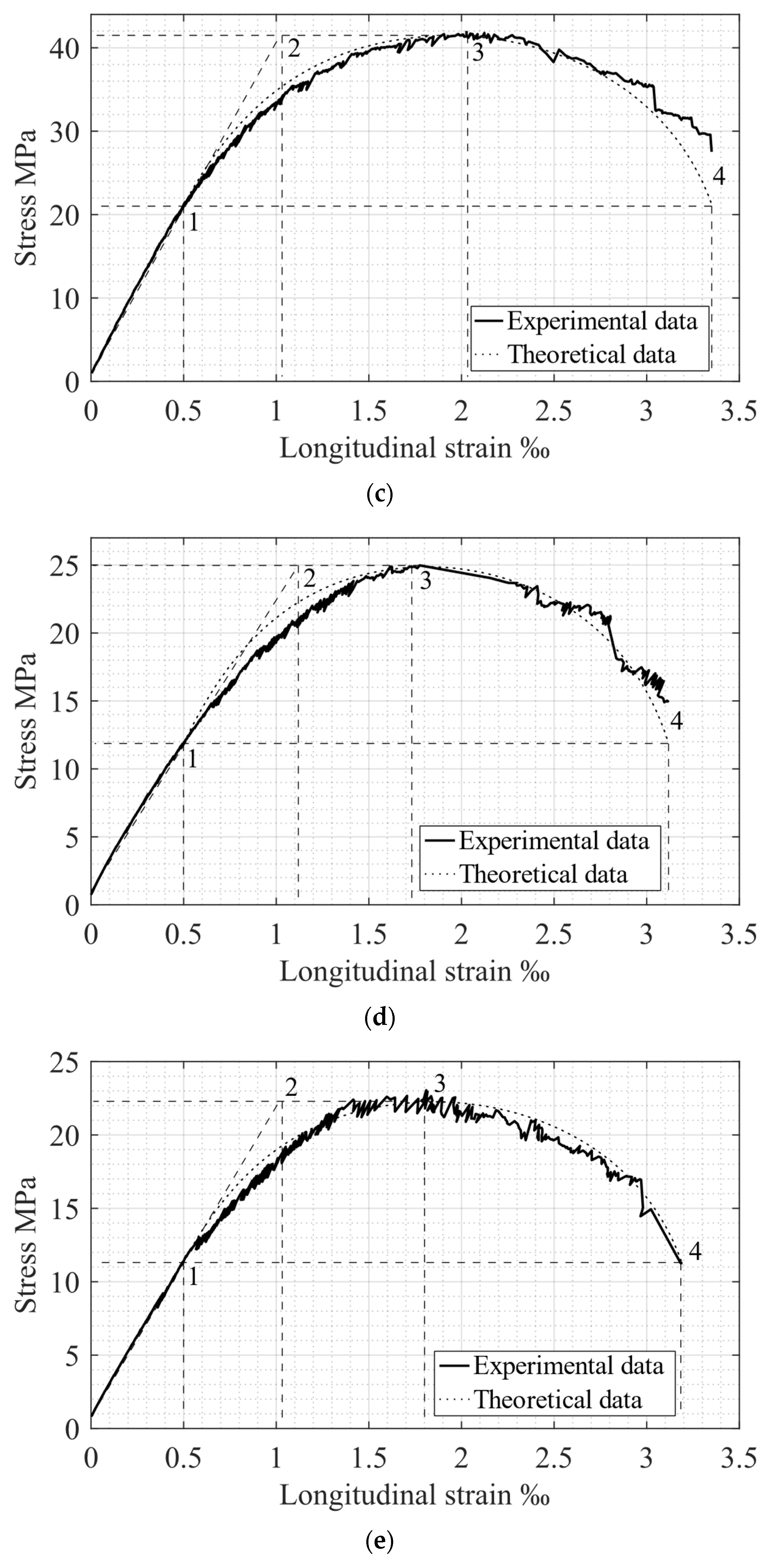1. Introduction
The stress-strain relationship is the fundamental feature of concrete response under external loads in the entire range of its behavior. Currently, available models describing this relationship are mainly based on experimental data. This approach is also reflected in modern design codes [
1,
2].
One of the first attempts to investigate the compressed concrete stress-strain (
) relationship was conducted at the beginning of the previous century [
3]. Later, Hognestad investigated 190.5 cm-long compressed concrete column specimens with square sections of 25.4 × 25.4 cm and 223.5 cm long ones with circular sections 30.5 cm in diameter [
4]. An analytical parabolic model was proposed to describe the ascending branch of the diagram, and the descending branch was represented by a linear dependence. This model was later modified by using new experimental data obtained for concrete specimens with a height-to-diameter ratio of 2 subjected to compressive loading controlled by a constant deformation rate [
5,
6]. However, the modified model is described by a more complicated mathematical expression. In the authors’ opinion, it is a general problem of empirical relationships that leads to the questionable accuracy of models and does not have theoretical confirmation.
The empirical relationship between
and
for compressed concrete, presented earlier [
5], was further investigated [
7,
8]. Modified versions of the empirical coefficient were proposed to consider the stress-strain diagram shape [
7] and the changes in concrete modulus of elasticity [
8]. Additionally, the descending branch curve of this diagram was also determined by these models [
7,
8]. Additionally, the model, which has experimental and theoretical significance, was proposed for simplifying the procedure, assuming parameters of a section, such as low axial strains, transverse deformations, and elastic behavior. Besides that, this method is an approximated one and can be easily implemented [
9]. Analysis of available theoretical and experimental studies shows that the problem of using empirical coefficients to describe concrete behavior remains relevant in recent years [
10,
11,
12].
According to the modern design codes [
1,
2], the
relationship for normal strength compressed concrete classes up to C60 is a diagram that includes a linear part in the elastic zone and a convex parabolic curve in the non-elastic one. Following those codes, ultimate elastic–plastic deformations of compressed concrete are equal to 2‰, and considering the descending branch—3.5‰—the concrete elastic behavior stage is limited by 40% of the strength.
An important issue is obtaining the descending branch of the compressed concrete
diagram because this branch, together with the ascending one, determines the potential of concrete in compression, which is essential for dynamic loads [
13]. It should be noted that when analyzing concrete response in the descending branch range, some researchers consider the modulus of elasticity as a negative value [
14]. In our opinion, the algebraic sign of the modulus, in this case, is not important and only emphasizes a significant reduction in concrete stresses. However, the exact stage up to which the mentioned stress reduction occurs is more important. The definite answer to this question is given in RILEM recommendations [
15], stating that the stresses decrease to half the concrete’s load-bearing capacity, i.e., to
. The present study is also focused on this problem.
Another issue related to the descending branch investigation is considering the joint work of a testing machine and a compressed specimen. The influence of a testing machine’s insufficient stiffness on the obtained deformations in the compressed concrete specimen was identified [
16,
17]. As a result, using a closed-loop testing machine controlled by specimen strain feedback was proposed for obtaining a full stress-strain diagram for compressed concrete [
15,
18,
19]. Some other requirements for test specimens were formulated based on available experimental results [
15,
20]:
- –
Provide a certain ratio of specimen height to its cross-section size;
- –
Take into account the friction between a specimen and planes of a testing machine and reduce this influence as far as possible;
- –
A minimum of three longitudinal external sensors should be placed around a specimen between testing machine plates;
- –
The loading rate should correspond to the static loading (about 0.1 μm/s).
The present research is devoted to in-depth experimental investigations of the above-mentioned problems, including new methods for their implementation. In particular, this investigation is based on the previous theoretical results and on generalizing the
model [
13], as well as the Mini-Max Principle [
21], the Quasi-isotropy concept of the RC element at the ultimate limit state (ULS) [
22], and the Structural Phenomenon [
23].
3. Short Description of the Theoretical Stress–Strain Model
The theoretical stress-strain model for compressed concrete is based on the following three known principles: the Mini-Max Principle [
21], Quasi-isotropy concept of RC element at ULS [
22], and the Structural Phenomenon [
23]. Each of these principles provides an additional equation (or system of equations) for determining RC element parameters under uniaxial compression, compression with eccentricity, and bending at ULS [
21]. This enables the design of such elements without additional empirical coefficients. The summary of each of these three principles is presented below.
The Mini-Max Principle idea is determined by obtaining the real load-bearing capacity of the structure, avoiding under- or over-estimation [
21]. This becomes possible by selecting the compressed zone section depth (static parameter), which corresponds to the simultaneous implementation of the structure’s maximum load-bearing capacity when the external load value acting on the failure zone (kinematic parameter) reaches its minimum. As a result, the Mini-Max Principle provides a solution for the unity theorem of the limit equilibrium method by combining the static and kinematic approaches in the same calculation, which means using both extreme features of failure load. At the same time, only one method is used in calculations according to the limit equilibrium method—kinematic or static.
The essence of the Quasi-isotropy idea is that a bent reinforced concrete element section at ULS is calculated assuming that it is made of a non-linear isotropic material [
22]. This approach enables the obtainment of an effective section with a minimum reinforcement ratio while the compressed zone depth reaches its maximum value, equal to half of the effective section depth [
24]. As a result, an additional equilibrium equation is obtained. This excludes the need for empirical coefficients, similar to the case when the Mini-Max Principle was applied.
The Structural Phenomenon was proposed as a result of extensive experimental and theoretical data analysis of reinforced concrete structures’ behavior at three levels: the material level and levels of static and dynamic loadings [
23]. The phenomenon’s essence is that parameters of material and structure at ULS increase or decrease twice compared to the values in the elastic state. This phenomenon was proved for symmetrical sections of structural elements subjected to symmetrical loading. Using the Structural Phenomenon, as well as the above-described principles, provides additional equations that also eliminates the empirical coefficient.
It can be summarized that using the above-described principles allows to obtain theoretical solutions to many new and existing problems, which could be previously solved by using empirical coefficients. Thus, further development of the limit equilibrium method and the general theory of reinforced concrete elements became possible.
The three above-described principles enabled the formulation of the main provisions for the theoretical model of the compressed concrete stress-strain relationship (
Figure 1) [
13]. The novelty of this model was the theoretical approach for finding the stress-strain diagram parameters without applying the empirical coefficients. The main parameters of this diagram for concrete classes up to C50 are:
- –
The maximum value of elastic deformations ;
- –
The limit concrete elastic potential determined by the deformation
(this potential is generally required for structural analysis under dynamic loads and for concrete creep analysis) [
25];
- –
The ultimate elastic stress reaching half of the concrete strength, i.e., ;
- –
The boundary of the diagram descending branch is determined by the stress equal to (helps find the real value of the compressed concrete cross-section potential).
6. Comparison of Experimental and Theoretical Results
As mentioned above, the main parameters for concrete behavior under compressive load are stresses and strains, determined by points 1–4 in
Figure 1 and
Figure 3. A comparison of the corresponding experimental and theoretical data is presented in
Table 5. Consequently, a graphical representation of theoretical and experimental
diagrams is shown in
Figure 5. The results of comparing the theoretical and experimental potentials values of the stress-strain diagrams [
13] are presented in
Table 6.
The analysis of the data presented in
Table 5 shows rather good convergence. A comparison of elastic and plastic potentials, presented in
Table 6, also demonstrates good agreement between theoretical and experimental results. Further comparison of the relation between
and
confirms the Structural Phenomenon concept [
23]: the elastic parameters increase twice when specimens reach the plastic stage. Taking everything into account, the entire range of the obtained experimental data and its comparison with the theoretical one completely confirms the proposed theoretical stress-strain model for compressed concrete.
7. Conclusions
The experimental results fully confirm the following main parameters of the theoretical stress-strain model for compressed concrete:
- –
Stresses and strains define the border between the elastic and inelastic compressed concrete behavior;
- –
The elastic potential of compressed concrete is important for dynamic analysis and investigations of reinforced concrete structure creep.
In the frame of the present research, geometrical correspondence between the descending branch in the compressed concrete stress-strain diagram and the ascending one was verified. It was also confirmed that the experimentally-obtained value of the descending branch limit stress is , which corresponds to the theoretical prediction.
The present experimental investigations fully confirm the theoretical stress-strain diagram of compressed concrete. As a result, this diagram can be called the “Law of Concrete” and included in the modern concrete theory. This law ensures the proper and accurate design of compressed reinforced concrete elements without empirical coefficients, which is important for the further development of structural concrete theory.















